CIVIL TECHNOLOGY GRADE 12 MEMORANDUM - AMENDED SENIOR CERTIFICATE EXAMS PAST PAPERS AND MEMOS MAY/JUNE 2018
Share via Whatsapp Join our WhatsApp Group Join our Telegram GroupCIVIL TECHNOLOGY
GRADE 12
AMENDED SCE PAST PAPERS AND MEMOS
MAY/JUNE 2018
MEMORANDUM
QUESTION 1: CONSTRUCTION, SAFETY AND MATERIAL
1.1
1.1.1 A hard hat will:
- protect the worker from any head injury. ✔
- protect the worker from falling objects from above.
ANY ONE OF THE ABOVE OR ANY OTHER ACCEPTABLE ANSWER (1)
1.1.2 The worker can wear a dust mask/respiratory mask/gas mask/ protective overall. ✔ (1)
1.1.3 If the worker does not use the safety equipment:
- His/Her eyes can be damaged by the dust ✔
- Debris can get into his/her eyes
- Any part of his/her body can be injured if he/she is not wearing a protective overall.
- Hearing can be damaged if ear protection is not used
- Dust can be inhaled
ANY ONE OF THE ABOVE OR ANY OTHER ACCEPTABLE ANSWER (1)
1.2
1.2.1 Ear muffs ✔ (1)
1.2.2 In a working area where machine and equipment makes loud noises/sounds. ✔
ANY OTHER ACCEPTABLE ANSWER (1)
1.3
1.3.1 SA or Howe roof truss ✔ (1)
1.3.2
A – King post ✔
B – Queen post ✔
C – Rafter ✔ (3)
1.3.3 The slope/gradient of a roof truss used for a thatch roof must be 45˚ and the roof truss in FIGURE 1.3 has a slope of 30°.✔
ANY ONE OF THE ABOVE (1)
1.3.4
- Concrete tiles ✔
- Clay tiles
- Slate tiles
ANY ONE OR OTHER ACCEPTABLE ANSWER (1)
1.4
- DPC is used between the concrete floor and the wall between courses of brickwork. ✔
- DPM is used under a concrete floor to cover the whole area of a room or a building or as roof underlay. ✔ (2)
1.5 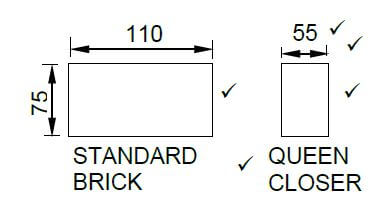 (5)
(5)
ASSESSMENTCRITERIA | MARK | CANDIDATE'S MARK |
Correctness of elevations | 2 | |
Labelling of views | 1 | |
Correct dimension lines and | 1 | |
Width of queen closer | 1 | |
TOTAL: | 5 |
1.6
- Galvanising is more expensive than painting but lasts longer than painting✔
OR - Painting is cheaper than galvanising and gives a wide variety of colours and surface finishing's.
ANY ONE OF THE ABOVE (1)
1.7
- Varnish ✔
- Oil
- Wax
- Coal tar creosote
- Paint
- Poisonous chemical salts (water and soluble salts)
- Organic compounds
ANY ONE OF THE ABOVE (1)
1.8 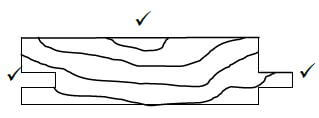 (3)
(3)
ASSESSMENTCRITERIA | MARK | CANDIDATE'S MARK |
Tongue(can be in the middle) | 1 | |
Groove(can be in the middle) | 1 | |
Board | 1 | |
TOTAL: | 3 |
1.9 Cement binds the ingredients of concrete together. ✔ (1)
1.10
- Mass concrete – is a volume of concrete that do not have any reinforcing✔
- Reinforced concrete – is concrete that is reinforced with steel rods to strengthen the structure✔ (2)
1.11
- Compacting by hand (rodding and spading) ✔
- Compacting through vibration (Mechanical vibrator)
ANY ONE OF THE ABOVE (1)
1.12
- A slump test is used to test workability/consistency of concrete. ✔
- A cube test is used to test compressive/crushing strength of concrete. ✔ (2)
1.13
- Cover strip/H-strip/Decorative grid strips ✔
- Jointing /ceiling tape/Gauze
- Jointing compound (rhinolyte)
ANY ONE OF THE ABOVE
QUESTION 2: ADVANCED CONSTRUCTION AND EQUIPMENT
2.1
2.1.1
- A – Steel capping ✔
- C – Steel tip ✔ (2)
2.1.2 Undisturbed earth ✔ (1)
2.1.3 A drop hammer ✔ (1)
2.1.4 Pre-cast concrete piles can be used when:
- The soil is not stable/soft ✔
- Water content of soil is high ✔
- There's a highwater table
- Subsoil is subject to movement
- Filling materials are not sufficiently compacted
ANY TWO OF THE ABOVE OR ANY OTHER ACCEPTABLE ANSWER (2)
2.2
- Bring the water level in the one side of the transparent pipe in line with the first level. ✔
- Take the other end of the pipe to the other position where the level must be transferred, maintaining the first level and make a mark next to the water level at this point. ✔ (2)
2.3
- Tape measure ✔
- Chalk line ✔
- Builders line ✔
- Builders square
- Straight edge
- Spirit level
ANY THREE OF THE ABOVE OR ANY OTHER ACCEPTABLE ANSWER (3)
2.4
2.4.1 Angle grinder ✔ (1)
2.4.2 Grinding/cutting disc ✔ (1)
2.4.3
- The safety guard protects the worker against sparks or debris from discs and materials. ✔
- The safety guard protects the body parts of the worker against the rotating blade.
ANY ONE OF THE ABOVE (1)
2.5
2.5.1
- Centre/Turning piece/Profile ✔ (1)
2.5.2
- Key brick ✔ (1)
2.6
- A – Compression force ✔
- B – Tensile force ✔ (2)
2.7  (10)
(10)
ASSESSMENTCRITERIA | MARK | CANDIDATE'S MARK |
6 Courses of bricks above the two existing courses | 2 | |
Mortar between brickwork | 1 | |
Symbol for concrete in the cavity between the walls | 1 | |
The symbol for concrete in the foundation | 1 | |
The symbol for back filling on one side only | 1 | |
The damp proof between the walls and the cavity | 2 | |
The weep hole | 1 | |
One wall tie | 1 | |
TOTAL: | 10 |
2.8 Dry wall ✔ (1)
2.9 Disadvantages of drywalls:
- They are less soundproof than brickwork. ✔
- They are less fireproof that brickwork.
- Drywalls must be joined together or attached to existing walls, to ensure sturdiness.
- Drywalls cannot carry heavy loads.
ANY ONE OF THE ABOVE (1)
2.10
2.10.1
- A - Anchor bar ✔
- B - Shear bar ✔ (2)
2.10.2 Structural failure will occur ✔ (1)
2.10.3
- To keep the main or anchor bars together. ✔
- Helps to resist shear stress
ANY ONE OF THE ABOVE (1)
2.11
A - Threaded rods and nuts✔
B – Laggings ✔
C – Lining✔
D – Collar ✔
E - Vertical clamps✔ (5)
2.12 C, B, A (1) [40]
QUESTION 3: CIVIL SERVICES
3.1 3.1.1 E ✔ (1)
3.1.2 G ✔ (1)
3.1.3 D ✔ (1)
3.1.4 F ✔ (1)
3.1.5 C ✔ (1)
3.1.6 B ✔ (1)
3.2 A water trap is installed:
- under sinks ✔
- baths
- toilets
- at a gully
- at a shower
ANY ONE OF THE ABOVE (1)
3.3 P trap or S trap or Bottle trap ✔ (1)
3.4
3.4.1  ✔✔ (2)
✔✔ (2)
3.4.2  ✔✔ (2)
✔✔ (2)
3.4.3  ✔✔ (2)
✔✔ (2)
3.5 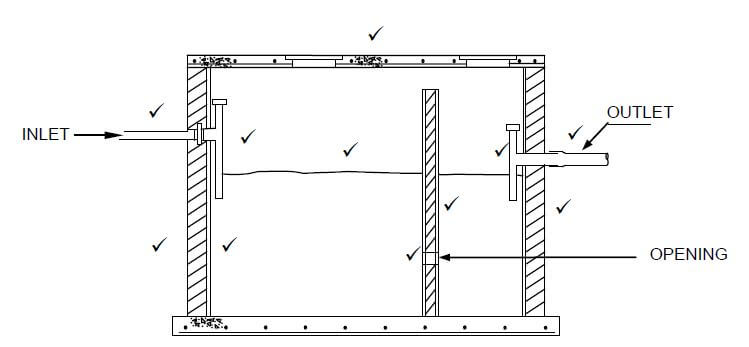 (11)
(11)
ASSESSMENT CRITERIA | MARK | CANDIDATE'S MARK |
External walls with plaster and holes | 3 | |
Inner wall with hole and plaster | 2 | |
Inlet pipe with T-junction | 2 | |
Outlet pipe with T-junction | 2 | |
Liquid level | 1 | |
Concrete cover with manholes | 1 | |
TOTAL: | 11 |
3.6
- Boreholes ✔
- Wells
- Rain water
- Snow
- Rivers
- Desalination
ANY ONE OF THE ABOVE OR ANY OTHER ACCEPTABLE ANSWER (1)
3.7 Storm water systems are used to carry storm water to rivers or low-lying dams. ✔ OR ANY OTHER ACCEPTABLE ANSWER (1)
3.8
- Solar energy ✔
- Nuclear power
- Hydro electricity
- Wind
- Natural gas
- Generator
- Inverter
ANY ONE OF THE ABOVE (1)
3.9
- Solar geysers are environmentally friendly. ✔
- Solar geysers can be used in areas where no electricity is available.
- Hot water is available at a very low cost once the installation cost has been covered.
ANY ONE OF THE ABOVE OR ANY OTHER ACCEPTABLE ANSWER (1)
3.10
- Using solar power as an alternative source of power. ✔
- Using appliances only when necessary.
- Using of low energy or LED light bulbs.
- Switch of lights in rooms that are not in use.
- Shower for shorter periods to prevent over use of geyser.
- Boil only the required quantity of water for a purpose.
- Use a geyser timer
- Use of gas
ANY ONE OF THE ABOVE OR ANY OTHER ACCEPTABLE ANSWER (1) [30]
QUESTION 4: QUANTITIES, MATERIALS AND JOINING
4.1
4.1.1 B ✔ (1)
4.1.2 C ✔ (1)
4.1.3 D ✔ (1)
4.1.4 A ✔ (1)
4.1.5 C ✔ (1)
4.2
4.2.1 2 030/2 030 mm ✔ (1)
4.2.2 1 ✔ (1)
4.2.3 44/44 mm ✔ (1)
4.2.4 813/813 mm ✔ (1)
4.2.5 200/200 mm ✔ (1)
4.2.6 32/32 mm ✔ (1)
4.2.7 220/220 mm ✔ (1)
A | B | C | D |
Centre line: Superstructure | |||
2/ 7 000 mm = 14 000 mm ✔ | |||
2/ 4 200 mm = 8 400 mm ✔ | |||
TOTAL: = 22 400 mm | |||
Minus 4/ 220 = 880 mm ✔ | |||
= 21 520 mm ✔ (4) | |||
1/ | 21,52 ✔ | Area of walls for superstructure | |
2,6 ✔ | 55,95 m² ✔ | (3) | |
1/ | 2.1 ✔ | Area of side door | |
0,9 ✔ | 1,89 m² ✔ | (3) | |
1/ | 2,4 ✔ | Area of garage door | |
2,1 ✔ | 5,04 m²✔ | (3) | |
1/ | 1,5 ✔ | Area of window | |
0,45 ✔ | 0,68 m²✔ | (3) | |
Total area of wall after deductions | |||
= 55,95 m²- 1,89 m² - 5,04 m² – 0,68 m² ✔ | |||
= 48,34 m² ✔ (2) | |||
(18) |
[30]
QUESTION 5: APPLIED MECHANICS 5.1
(A1 x d) + (A2 x d)
Total area
✔ ✔ ✔ ✔
= (3 600 mm² x 30 mm) + (900 mm² x 70 mm)
4 500 mm² ✔
= 108 000 mm³ + 63 000 mm³ ✔
4 500 mm²
= 171 000 mm³
4 500 mm² ✔
= 38 ✔ mm OR
Part | Area | X | AX |
1 | 60 mm x 60 mm = 3 600 mm² ✔ | 30 mm ✔ | 108 000 mm³ |
2 | 15 x 60 = 900 mm² ✔ | 70 mm ✔ | 63 000 mm³ |
∑ | 4 500 mm² ✔ | 171 000 mm³ |
X = ∑Ax
∑A
= 171 000 mm³ ✔
4 500 mm² ✔
= 38 mm ✔ ✔ (9)
5.2 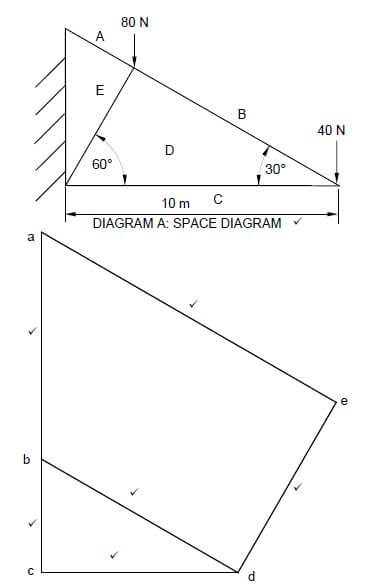 (1)
(1)
(6)
NOT ACCORDING TO SCALE
USE A MASK TO MARK THIS QUESTION
MEMBER | NATURE |
AE | Tie ✔ |
BD | Tie ✔ |
CD | Strut |
DE | Strut ✔ |
Tolerance of 1 N to either side. (3)
5.3
5.3.1 16 N ✔ (1)
5.3.2 4 m ✔ (1)
5.3.3 6 m ✔ (1)
5.3.4 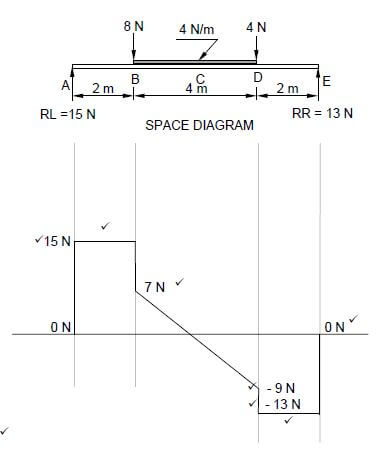 (8)
(8)
Correct shape ✔✔
SHEAR FORCE DIAGRAM
USE A MASK TO MARK THIS QUESTION
ASSESSMENT CRITERIA | MARKS | CANDIDATE'S MARK |
Correct shape of shear force diagram | 1 | |
Value of shear forces correctly measured and indicated | 5 | |
Horizontal lines indicated | 2 | |
TOTAL | 8 |
If the drawing is not drawn to the correct scale, penalise the candidate with 1 mark. [30]
QUESTION 6: GRAPHICS AND COMMUNICATION
CENTRE NUMBER: |
EXAMINATION NUMBER: |
ANSWER SHEET 6.1
NO. | QUESTIONS | ANSWERS | MARKS |
1 | Identify the type of eave construction used in the drawing. | Open eave | 1 |
2 | State the minimum pitch (slope) of number 1, if galvanised roof sheeting is used. | 5° - 10° | 1 |
3 | Identify number 2. | Tie-beam | 1 |
4 | State the standard dimension of number 3. | 38 mm x 38 mm | 1 |
5 | State the purpose of number 4. | To cover the opening between the wall and the ceiling. | 1 |
6 | Name the timber that is shown on top of the external wall marked number 5. | Wall plate | 1 |
7 | Draw the drawing symbol for number 6 in the next column. | 2 | |
8 | Explain the purpose of number 7. | To prevent dust, insects, rodents, wind and birds to enter the building | 1 |
9 | Name ONE material that can be used for number 8. | PVC, aluminium, galvanised sheet metal. | 1 |
10 | Identify number 9. | Fascia board | 1 |
11 | Identify number 10. | Down pipe | 1 |
12 | Draw a neat freehand line diagram of a Fink or W roof truss in the next column. |  | 3 |
TOTAL: | 15 |
CENTRE NUMBER: |
ASSESSMENT CRITERIA | MARKS | CANDIDATES MARK |
External walls | 2 | |
NGL (correctly drawn) | 1 | |
FFL (correctly drawn) | 1 | |
Window | 1 | |
Window sill | 1 | |
Door opening | 1 | |
Step | 1 | |
Fascia board | 1 | |
Rain-water down pipe | 1 | |
Roof (correctly drawn) | 2 | |
Gutter | 1 | |
Ridge capping | 1 | |
Determining roof height | 4 | |
Any FOUR labels | 4 | |
Application of scale One or two incorrect = 3 Three or four incorrect = 2 More than five incorrect = 1 No measurement correct = 0 | 3 | |
TOTAL | 25 |
EXAMINATION NUMBER: |
ANSWER SHEET 6.2 
NOT TO SCALE: USE A MASK TO MARK THIS QUESTION
- Application of scale ✔ ✔ ✔
- Any four labels ✔ ✔ ✔ ✔